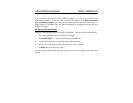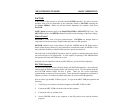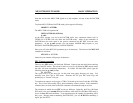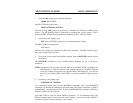
MFJ-1278B MULTI-MODE BASIC OPERATION
To prevent Uncontrolled Disconnects, we are unable to listen to all kinds of third party Pactor
transmissions for (WAIT x Cycle_Time) seconds after receiving the other side's last
disconnect. This includes all unproto and connected packets, along with connect requests. The
actual cycle time is 1.25 or 1.4 seconds.
CONNECT
[Connect] message: The MFJ-1278B monitors connect attempts received from other
station's with a message containing the called station's callsign when idle. To successfully
monitor a connect attempt to someone else, the called callsign must be at least 4 characters
in length, and the signal be of sufficient quality that the 200 baud area be error-free when
received. Unfortunately, the callsign in the connect-attempt packet (unlike all other
monitored data) is subject to corruption; the Pactor protocol did not provide for error- free
connect packets. Therefore, you may at times see a garbled callsign in a [Connect] message,
but it should be rare. Remember, this "garbling" affects only monitored connect-attempt
packets. It does NOT affect ARQ or FEC data packets because they are error-protected by a
sophisticated CRC checking scheme.
SPEEDup/SPEEDdown
Speedup and speeddown: When the MFJ-1278B is the receiving station or IRS, and after
four consecutive failures to receive a 200 baud packet the TNC requests a SPEEDDOWN to
100 baud. A SPEEDUP occurs when the MFJ-1278B receives 10 error free 100 baud
packets. If NO200 is set to ON all SPEEDUP requests are inhibited
Bad band conditions: During poor band conditions links will be quicker by avoiding use of
the 200 baud mode. Setting NO200 to ON instructs the MFJ-1278B to avoid 200 baud
operation in a compatible way.
AUTOMATIC ON-LINE COMPRESSION
Huffman coding: Huffman coding offers somewhere between 2:1 and 4:1 compression on
lower case German and English plain text. In receiving modes, conversion to 8 bit data is
automatic.
On transmit, the MFJ-1278B packetizes outgoing data and transparently selects the mode.
Huffman coding will be used if a) all data are 7 bit ASCII characters, and b) Huffman
coding is at least as efficient as straight 8-bit coding.
FLOW CONTROL
Flow control: Hardware flow control is always on. Software flow control defaults to on
using the XON and XOFF parameters. Unlike TNC operations, the same characters are used
for receive flow control as for transmit flow control. Type-in flow control is only effective
while entering commands at the "p_cmd:" prompt.


















